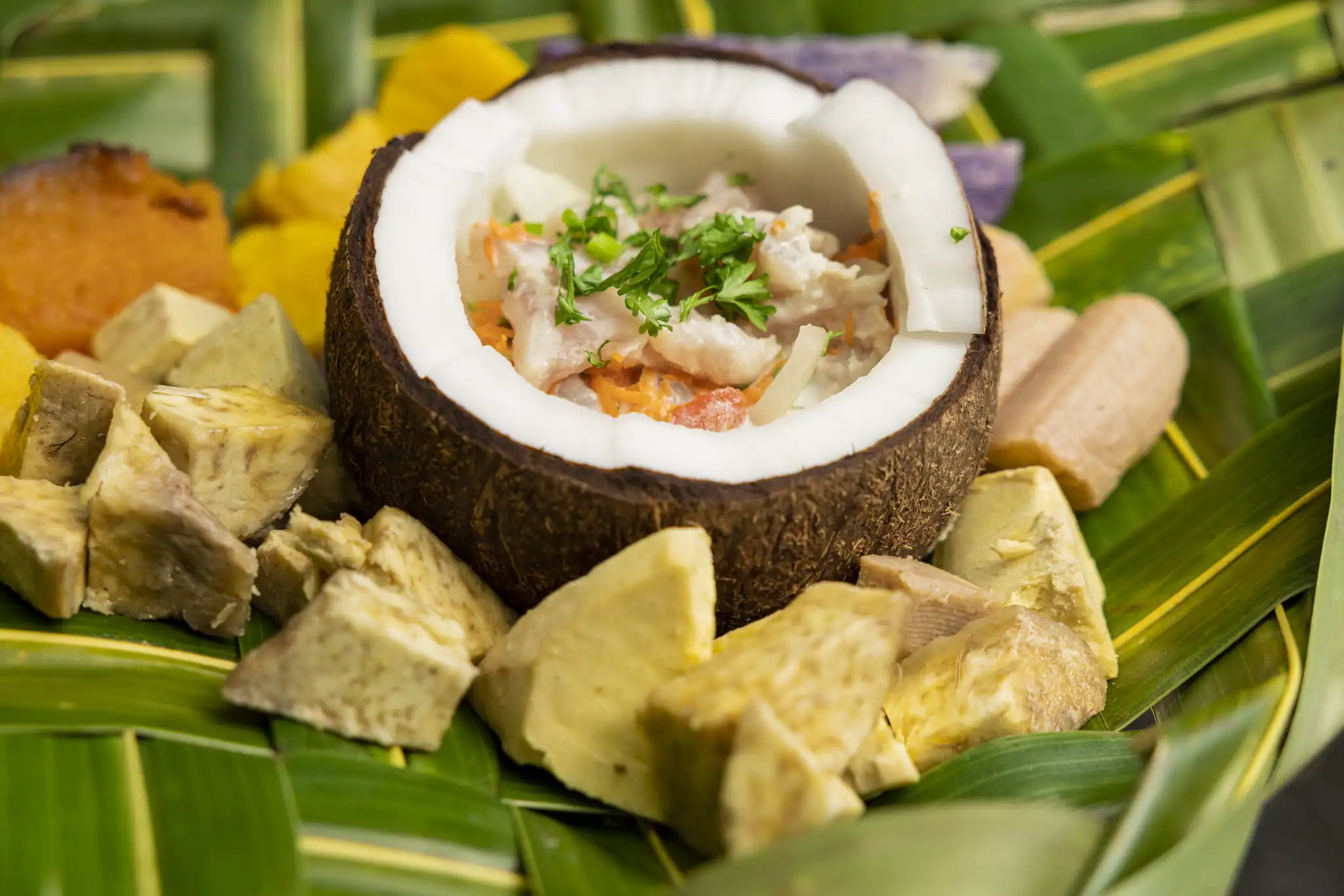In Tahiti, cooking is much more than a necessity: it’s a true celebration! Traditional dishes aren’t prepared every day; weekends are reserved for having the time to prepare everything. During the week, people might revisit a single dish, whether it’s made with legumes or drizzled with coconut milk.
It’s a way of life, a legacy passed down through generations, and a vibrant expression of Polynesian identity. We dip our hands into the dough to prepare a po’e, a traditional dessert made with fruit (often banana or papaya) and coconut milk, steamed and served soft and fragrant. We cut open an uru (breadfruit), whose floury, sweet flesh can be roasted, boiled, or fried, making a wonderful accompaniment to main dishes.
Dishes are simmered over a wood fire, an ancestral method that gives the food an incomparable smoky flavor.
Or we squeeze freshly grated coconut, its creamy, rich milk being the key ingredient in many dishes, from the famous raw fish in coconut milk to sauces accompanying meat and vegetables, adding a touch of exoticism and sweetness to every bite.
Tahitian cuisine is a symphony of flavors, textures, and aromas, an invitation to discover the soul of the island through its culinary delights.
The taste of fenua
A tribute to freshness, Polynesian cuisine draws on Maohi, Asian, and European influences. It showcases the treasures of the land and sea: fish, taro, uru, fē’i bananas, and coconuts, prepared with skill and respect.
But before cutting, grating, and squeezing, a little ritual is required: putting on your pareo. This also applies to men! It’s not just a matter of vanity, but of feeling comfortable, free to move, and grounded in the present moment. Here, we cook barefoot, fully connected.
→ And to really get into the fenua spirit, we play one of the music playlists from Tahiti and its islands.
Let the sunny melodies, ukulele tunes, reggae accents, and beautiful Polynesian voices brighten up your kitchen. We’ve prepared everything you need in all musical styles.
Ahi mā’a: the sacred fire
The traditional Tahitian oven—the ahimā‘a—is much more than just a cooking method. It is a collective ritual. Food is wrapped in leaves, buried in a pit heated with volcanic rock, then covered for slow, thorough cooking. A passing on of skills, a moment of sharing.
→ What if you live in a city?
You can recreate the spirit of ahimā‘a without digging a pit in the garden:
→ low-temperature cooking in a domestic oven
→ steaming in banana leaves (available from Asian grocery stores)
→ wood-fired oven, cast iron casserole dish, or closed barbecue
→ And for presentation, consider making your own plant-based plates.
In Polynesia, coconut leaves are woven or banana leaves are used.
→ Outside of Polynesia, choose non-toxic edible leaves such as green cabbage, grapevine leaves, or dried corn husks.
→ Avoid potentially toxic decorative plants (oleander, lily of the valley, etc.).
→ Otherwise, opt for natural containers: wood, bamboo, or reusable food-grade silicone.
Classics revisited
Among the iconic dishes that are a must-try are:
→ Raw fish in coconut milk: refreshing and tangy, a symbol.
→ In mainland France, replace tuna with salmon, sea bass, or meagre; remember to freeze it for 24 hours beforehand if eating it raw.
→ Fāfā chicken: simmered with taro leaves.
→ Alternatively, use spinach, Swiss chard, or sweet potato leaves, which are perfect for cooking in coconut milk.
→ Po’e : A creamy dessert made with banana, papaya, or pumpkin, topped with coconut milk. Can be made with fruit purée and starch.
→ Fāfaru : fermented fish.
→ For a milder version, try a marinade made with mild nuoc-mâm or diluted miso.
→ Coconut bread: soft and slightly sweet. Add a hint of Tahitian vanilla for a subtle aroma.
→ For more information, visit chefsdetahiti.pf/recipes for other Polynesian recipe ideas.
The white gold of the Pacific
Coconut is everywhere: water, flesh, milk, oil… It enriches savory and sweet dishes, and even natural skincare products.
Cuisiner local, simplement
Adopting local products means supporting local agriculture and rediscovering the seasons:
→ Visit the markets
→ Choose fresh ingredients
→ Revisit recipes from yesteryear
→ Get creative with your presentation
→ Put on a Tahitian playlist to cook with a smile
Conclusion
Cooking Tahitian style means dressing in a pareo, listening to Polynesian music, weaving a plate, grating by hand, smelling the smoke, and passing on memories. Wherever you are, reconnect: cook locally.
About the author
Ruben Chang is passionate about his homeland, his fenua, the sounds and stories that move him. Creator of tahiti-agenda.com in 2007 and front-end developer for the REDSOYU agency, he explores the cultures, technologies and stories that link the islands on a daily basis.
Related website
Discover the Chefs de Tahiti website . Its mission is to showcase local Polynesian cuisine around the world.
Featuring chef profiles, recipes, expertise, and the culinary flavors of Polynesia. Tahitian recipes and local products.



